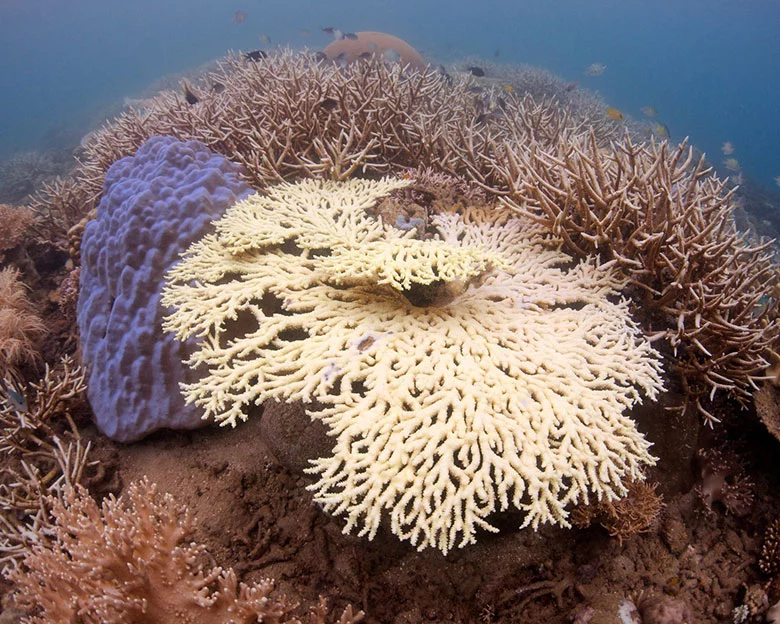Are you aware of the threats that coral bleaching poses to our oceans and economy? The world’s coral reefs are critical to the survival of many aquatic species and provide essential services such as protection, shelter, and food.
However, human activities such as global warming, land clearing, coastal construction, and chemical contamination are causing above-average seawater temperatures, leading to coral bleaching.
Coral bleaching occurs when coral polyps expel the algae living inside their tissues due to high seawater temperatures. This phenomenon is becoming increasingly common, and the loss of coral reefs could have severe consequences for our planet.
This article will explore the causes and mechanisms of coral bleaching, its impact on ecosystems, the economic consequences of losing coral reefs, and the urgent need for conservation efforts to protect these vital ecosystems.
Join us as we delve into the fascinating world of coral reefs and the threats they face.
Key Takeaways
- Coral bleaching is caused by above-average seawater temperatures, which force coral polyps to expel the algae living inside their tissues, resulting in white and colorless coral that often leads to disease and death.
- Coral is a fundamental species in the ecosystem of our oceans, and reduction in coral populations would be catastrophic not only to marine ecosystems but also to shoreline properties, resulting in a total and significant economic catastrophe.
- Coral reefs need to be protected through conservation efforts, including reducing greenhouse gas emissions, protecting marine environments, and promoting sustainable fishing practices.
- The loss of coral reefs could result in hunger, poverty, and political instability, making it a significant concern for the global community.
Causes and Mechanisms

You already know that coral bleaching is caused by above-average seawater temperatures, but did you know that it can also be caused by human activities such as land clearing and coastal construction?
When ocean temperatures rise above normal levels, coral polyps expel the zooxanthellae that live within their tissues. This loss of the algae causes the coral to turn white and become more vulnerable to disease and death. But it’s not just the temperature that can cause zooxanthellae expulsion – human activities such as land clearing and coastal construction can also introduce pollutants and sedimentation into the water, disrupting the delicate balance of the coral ecosystem.
In addition to temperature and human activities, coral bleaching can also be caused by factors such as solar irradiance, freshwater dilution, and inorganic nutrients.
The loss of zooxanthellae can be devastating for coral reefs, as they rely on these algae for essential nutrients and energy. Without them, coral becomes more susceptible to disease and death, and the ocean’s delicate ecosystem is disrupted.
It’s important to recognize the many complex causes of coral bleaching in order to take action to protect our oceans and the vital coral reefs within them.
Impact on Ecosystems
Imagine swimming in the ocean and coming across a world without the vibrant colors and life-sustaining habitat that coral reefs provide for countless aquatic species.
Coral bleaching, caused by rising sea temperatures and other human activities, has accounted for the loss of up to 50% of coral reefs in some areas. The ecological ramifications of this loss are immense, as coral reefs are home to over 25% of all marine species.
Biodiversity loss caused by coral bleaching can also have a ripple effect on the food chain and ecosystem as a whole. When coral dies, other species that rely on it for habitat or food can also suffer and die off, causing a cascading effect throughout the ecosystem.
The loss of coral reefs can also impact human communities that rely on the ocean for food and tourism, leading to economic instability. It’s critical that we take action to protect and preserve coral reefs to prevent further damage to both the ecosystem and the global economy.
Economic Consequences
The loss of coral reefs can have devastating economic consequences, impacting industries such as fishing and tourism that rely on healthy marine ecosystems. In fact, coral reefs are estimated to provide goods and services worth $375 billion per year.
The tourism industry alone generates $36 billion annually from coral reefs, with millions of people visiting coral reef destinations every year. However, if coral reefs continue to decline, this industry could suffer greatly, losing jobs and income for local communities.
The impact of coral bleaching on fisheries is also significant. Coral reefs provide habitat for a vast array of fish species, and the loss of these habitats could lead to a decline in fish populations. This is particularly concerning for developing countries that rely on fish as a primary source of protein and income.
In fact, the value of fish caught on coral reefs is estimated at $5.7 billion per year, with millions of people depending on these resources for their livelihoods. The loss of coral reefs could have severe consequences for these communities, resulting in increased poverty and food insecurity.
Conservation Efforts
Take action now to protect the vital ecosystems that support our planet before it’s too late. One of the most effective ways to preserve coral reefs is through the establishment of marine protected areas (MPAs).
MPAs are designated areas in the ocean that are protected by law, with restrictions on fishing, diving, and other human activities that can damage the marine environment. MPAs have been shown to increase fish populations, improve coral cover, and enhance the resilience of marine ecosystems to climate change.
In fact, a recent study found that MPAs can increase the abundance of fish by up to five times and the diversity of marine life by up to 20 times. Another way to protect coral reefs is through sustainable tourism.
Coral reefs are a major attraction for tourists, generating billions of dollars in revenue each year. However, unregulated tourism can harm coral reefs through physical damage, pollution, and overuse. Sustainable tourism aims to minimize these impacts by promoting responsible travel practices, such as using reef-safe sunscreens, avoiding touching or stepping on coral, and supporting eco-friendly businesses.
By adopting sustainable tourism practices, we can ensure that future generations can continue to enjoy the beauty and benefits of coral reefs while also supporting local economies and communities that depend on them.
Frequently Asked Questions
How Can Individuals Reduce Their Carbon Footprint To Help Prevent Coral Bleaching?
Reduce your carbon footprint and help prevent coral bleaching by adopting an eco-friendly lifestyle and sustainable practices. This includes reducing energy consumption, using public transportation, and consuming local, organic produce. Small actions can make a big impact on the health of our oceans.
How Does The Loss Of Coral Reefs Affect Tourism And The Hospitality Industry?
The loss of coral reefs significantly impacts the tourism and hospitality industry due to reduced revenue and job opportunities. Conservation efforts must be prioritized to prevent further damage and protect the livelihoods of those dependent on these industries.
Are There Any Natural Solutions Being Explored To Help Restore Damaged Coral Reefs?
You’ll be happy to know coral restoration using natural solutions is underway. Some methods include using artificial structures, coral gardening, and micro fragmentation. These solutions show promise for restoring damaged coral reefs.
What Role Do Government Policies Play In Protecting Coral Reefs And Preventing Coral Bleaching?
Government policies play a crucial role in coral conservation efforts, including reducing greenhouse gas emissions, protecting marine environments, and promoting sustainable fishing practices. Such policies are necessary to prevent coral bleaching caused by human activities and protect coral reefs for the entire ecosystem and the global economy.
How Do Coral Reefs Contribute To Scientific Research And Medical Advancements?
Like a treasure trove waiting to be discovered, coral reefs hold immense potential for scientific discoveries and medical advancements. Coral reef medical research has led to breakthroughs in cancer treatment and new antibiotics, among others.
Let’s Take Action To Preserve Coral Reefs For A Sustainable Future
You’ve learned about the devastating effects of coral bleaching on our oceans and economy. The causes of this phenomenon are multifaceted, ranging from global warming to human activities such as land clearing and coastal construction.
Coral reefs are a critical component of the ecosystem, providing shelter, protection, and food for many aquatic species. Their loss could lead to significant consequences, including hunger, poverty, and political instability.
The impact of coral bleaching is not limited to the aquatic world. It has economic consequences as well. Coral reefs generate billions of dollars in revenue annually through tourism, fishing, and other industries. Many coastal economies could suffer without them, resulting in job losses and decreased revenue.
As we look to the future, it’s essential to implement conservation efforts to ensure the survival of coral reefs. This includes reducing greenhouse gas emissions, protecting coastal habitats, and establishing marine protected areas.
We can protect these vital ecosystems and preserve them for future generations by taking action now. Let’s work together to ensure that coral reefs continue to thrive, providing a home for countless species and a source of economic prosperity for coastal communities.

